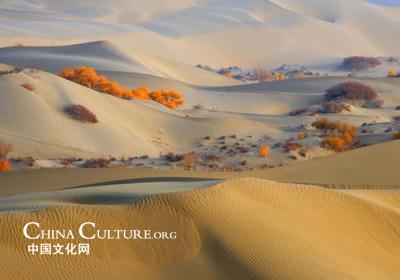
3. Gurbantunggut Desert in Xinjiang
The Gurbantunggut Desert, located in the center of Junggar Basin, to the east of the Manas River and south of the Ulungur River. With an area of 48,800 square meters, the desert is the second largest desert in China. Its climate is temperate. Its eco-environment is very fragile, and the impact of human activities on the eco-environment, including the building of a trans-desert highway, has been increasingly significant.The sand hills in the desert are 300 to 600 meters above sea level.


4. Singing Sand Dunes & Crescent Moon Spring in Gansu
Singing sand, is sand that produces sounds of either high or low frequency under pressure. The sound emission is usually triggered by wind passing over dunes or by walking on the sand. The sound is generated by shear stress.
The Crescent Moon Spring locates at 5km south of Dunhuang City in Gansu. Since time immemorial, the scenic spot is famous across the whole world for its “Coexistence of mountain and spring, sand and water”. It is appraised as “Unique Scenery in the north of Great Wall”, and listed as National Key Tourist Attractions of the People's Republic of China in 1994. About over 300 meters long and 50 meters wide, the Crescent Moon Spring is surrounded by Singing sand Dunes. The poplars stand elegantly beside the spring and fishes swim happily and leisurely. The spring water tastes fresh and sweet and water in the color of light blue.
